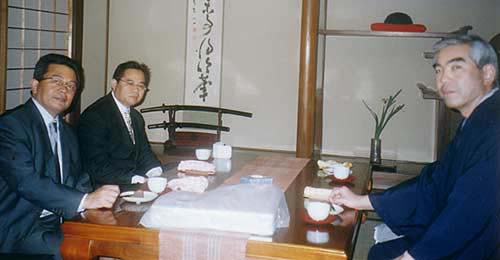

Ken and Aikido
Some understanding of the socio-political conditions of The Japanese feudal society would be useful for a better comprehension and appreciation of the historical place of the KATANA - The fabled Japanese sword -in Japanese history. The evolution of the KATANA was naturally closely associated with that of the Bushi or Samurai,the warrior class of feudal Japan. As warriors and master of the arts of war, The Bushi had themselves evolved from being employed as guards serving powerful leaders of the Heian and Fujiwara clans (Heian period 794-1185) into a dominant class of its own. The declining powers of the Japanese Emperor and the crushing victory of the Minamotos military clan over their bitter rival, the Taira clan, in the epic battle of Dannoura in 1185, eventually led to the establishment of the feudalistic military Kamakura Bakufu Shogunate which encouraged austerity and the pursuits of the martial arts and disciplines. The Kamakura-Bukufu Shogunate lasted 140 years (1192-1333) but the era established the Ways of the Bushido to dominate the Japanese feudal and social structures for the next 700 years until the Meiji Restoration of 1867 which saw the collapse of the Tokugawa Shogunate and the restoration of full sovereignty to the Japanese Emperor. The Bushi's primary role as military knights was their total and absolute allegiance to their peers for whom they were pledge to fight and if need be to die defending. They adhered to strict martial codes and disciplines and were uncompromising in their observance of honorable and chivalrous behaviors. Honor was their life and they would as soon embrace death than be dishonored. The best of the KATANA were produced during the Kamakura period. The Bushi's demand for dependable weapons of the highest quality produced KATANA of unrivalled perfection during the period. Today these KATANA still exist primarily due to the selfless dedication of scholars and artisan who had dedicated their life towards the preservation and studies of these weapons. The KATANA in fact has a very simple structure. But it is this very simplicity that has made it a reliable and lethal weapon to its master and has produced for it a sense of unrivalled beauty and dignity. It was inevitable that frequent warfare and feuds awakened desires for peace amongst the people. These desires were like fertile grounds for religous and cultural endevours. The Zen sect Rinzai-Shu and Soto-hu, introduced by Eisai and Dogen respectively, the "Zazen"(an exercise in sitting contemplation) to obtain spiritual awakening came widely accepted as counter balance to the Bushi quality of austere simplicity, rusticity, and dominating physical constitutions.
The tea introduced by Yousai and developed under the influence of Zen Buddhism was later followed by the formalities and manners that regulated the daily life of the Bushi. The tea ceremony or "Chanoyu" established by Sen-No-Rikyu in Momoyama culture at the end of the 16th Century were all part of an ongoing social and cultural evolution of feudal Japan in which the KATANA always held a place of intrinsic importance. The Meiji Restoration of 1867 banned possession of KATANA as arms except only to certain privileged class. Since then, only the KATANA which were in superb condition and of excellent quality have been preserved as national treasures. The preservation of these weapons were attributed to a few dedicated professionals and craftsmen. Amongst the best of these was the Rev.Yamada Eyi Kensai.
The Rev.Yamada Kensai (1912-1974) was a Zen priest, a KATANA scholar and a Master craftsman in the art of preserving and sharpening the KATANA. He had devoted his entire life to ensuring that this precious Japanese legacy would never be lost to future generations. He believed that if KATANA is left to inexperienced hands for sharpening or for removing blemishes from the surface, the KATANA may lose its fine qualities and its originality will be compromised. The loss will be irrevocable. The art of preserving the Katana therefore became an obsession for Rev. Yamada and turned into his life long work, and his boundless passion are reflected in all of his literary works("The Japanese Swords" Series 1-5 etc.). As a priest the Rev. is a gentle person and his passion for the study of the KATANA must appear strange at first but, in one of his works, the Rev. explained that "an allegiance to the KATANA is not to allow yourself to be used by the KATANA which itself is a lethal weapon made to hurt." The above philosophy is also clearly reflected in Aikido when O-Sensei said that "the object of Aikido is to be victorious without fighting." As part of this efforts he established "Chuo Token Kai"-a Society dedicated to The Study of the Japanese swords. The society was closed during the Second World War but was fortunately revived in postwar Japan at his residence in Tokyo, 1947. To Rev. Kensai, it is an obligation of mankind to pass on these rare treasures to the next generation. "Chuo Token Kai" has attracted many stinguished persons throughout Japan. H.Somemiya (Aikikai Hombu Shihan) whose dedication to Aikido Society is well known worldwide is one such member.During his lifetime Rev. Tansetu received many requests from distinguished personalities to care and maintain and preserve precious ancient KATANA. Aikido Second Doshu, The late Kisshomaru Ueshiba, who inherited O-Sensei's KATANA headed the list of prominent Aikidokas who entrusted the care of his KATANA to the Rev. The other include Shihans Chiba, Kanai, Shibata of USA, and Fujita Shihan of Hombu Dojo. Upon the death of Rev. Kensai, his second son, Yamada Seijiro inherited the proud family tradition of sword preservation and succeeded to leadership of the "Chuo Token Kai" whilst his elder son Jun Yamada - Aikido Shihan - has been living in Malaysia to teach Aikido.
 
|